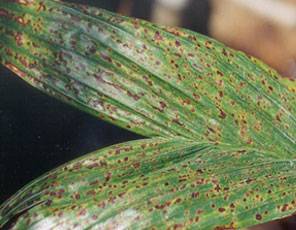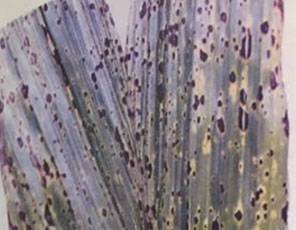Biology and Symptoms
One of the most common diseases in nursery. Soon after transplanting. Symptoms are depending on the causal pathogens. The mode of spread is mainly by airborne spore. The primary lesion produces spores which spread by heavy rain or excessive watering. Mostly occur in the main nursery and during pre-nurseries. A slight attack spreads rapidly to the surrounding seedlings. Attacks are severe under wet conditions or when seedlings are raised in peat soil.
Causal
a) Curvularia eragrostidis – Attack spear, showing small circular, translucent yellow spots, visible on both sides of leaf. The spots develop into light brown and later form a lesion. The lesion shape then becomes elliptical. Severe infection at the lowest and oldest leaves could kill the seedling.

b) Helminthosporium spp.- Cause tiny brown spot lesions which are scattered but would not enlarge or become chlorotic. They are numerous and localized, distally or centrally on the leaf. Some lesions cause rotting.
c) Drechslera halodes – Cause small green spots, later become bright yellow, with a broad and yellowish-green halo. It then blends with the healthy tissues. The centre of the lesion is a tiny, pale brown spot, which later darkens.

d) Cochliobolus carbonus
Similar symptoms as Drechslera. Attack young leaves and spear, causing tiny yellow spots. Narrow band of tissue around spots becomes cholorotic and necrotic. The cholorotic zone appears as a halo around the infected area.
Disease Management and Control
Good management practices are important to keep low incidence of disease by maintaining balanced nutrients in soil, adequate water supply, optimal shading, minimal damage and shock during transplanting into nursery. Overcrowding the seedlings and using peat as medium should be avoided. Severely infected seedlings should be removed and destroyed. Control at the early stage of infection, with either 0.2% Thiram (80% a.i) or 0.5% captan (50% a.i). Application should be made at intervals of 5-7 days until control has been achieved. Adjuvants must always be added.
